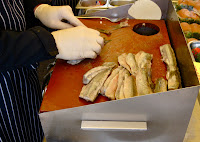My dad passed away many years ago and I haven't eaten herring since.
 While I was in Amsterdam, I wanted to try the local favorites. The Dutch love Gouda, beer, bitterballen--a crispy fried ball of meat and dough--and, of course, herring. I wanted to try them all.
While I was in Amsterdam, I wanted to try the local favorites. The Dutch love Gouda, beer, bitterballen--a crispy fried ball of meat and dough--and, of course, herring. I wanted to try them all.For Zesterdaily, I wrote about my experience eating herring in Amsterdam. It wasn't what I expected!
There are herring stands in the squares and on the busier canal bridges. Pretty much where ever people congregate you'll find a herring stand. The Dutch way to enjoy them is to eat the herring whole. Pick it up by the tail, tilt back your head, and let the fish descend into your mouth as you greedily ingest it.
Alternately, the fillet is sliced into fat pieces and served either on a plate or a roll with onions and pickles. I had read that a purist prefers the fish without condiments, not wanting anything to get in the way of the simple, clean flavor of the fish.

As people stand in line to buy herring, they crane their heads the better to watch the chef as he prepares the herring. When the fish is taken out of the brining pan, it has already been gutted and deboned. As the last act before serving, the skin and tail are efficiently removed in one quick stroke.
I wanted an authentic Dutch experience, but I wasn't sure I was ready for raw herring.
On a trip to the Friday morning cheese auction at Alkmaar, 30 minutes by train north from Amsterdam, there was a crowded area where vendors sold souvenirs, wax wrapped balls of cheese, pastries, and, of course, herring.
I watched as people pushed past me to grab paper plates of herring. As they ate, they smiled. I took that as a good sign, but even so, it took me a bit of time to work up the nerve to place my order.
 I was definitely not going the authentic route of grabbing the herring by the tail and eating it whole. And I opted not to have the roll. Reconnecting with my dad, I chose to eat my herring with onions.
I was definitely not going the authentic route of grabbing the herring by the tail and eating it whole. And I opted not to have the roll. Reconnecting with my dad, I chose to eat my herring with onions. I paid my 1.80 Euros ($2.35 U.S.) and picked up a plate of herring, raw onions, and a pickle. Using the toothpick-flag as a utensil, I tried a fat piece.
Like the best sashimi, the herring melted in my mouth. The fresh tasting fish had a pleasant sweetness, the onions added a crunch, the pickle tartness. All in all, a very good combination. The second bite was as good, but by the third I had started to have second thoughts. I didn't want to waste the fish, so I had a fourth piece, but that was the last.
Ultimately, the fish was just too rich for me.

I needed something else to eat, something that would change the taste in my mouth. I considered some fries (in Holland, call them frites, not "French" fries) but to eat them the Dutch way meant using mayonnaise instead of catsup. That didn't sound any better to me than it did to John Travolta in Pulp Fiction.

On the walk back to the train station, I saw a gelato shop, A.C. de Boer (12 Scharlo), and hoped that cold and sweet might trump the herring taste in my mouth.
There were a dozen flavors to choose from. They all looked good. Ultimately I settled on a scoop of vanilla and one of pistachio. I went outside in the sun and savored the creamy, cold sweetness. The vanilla might have been the best I'd ever eaten. Now I felt better.
Sorry, dad.














 ed by the full heat of the sun.
ed by the full heat of the sun.





